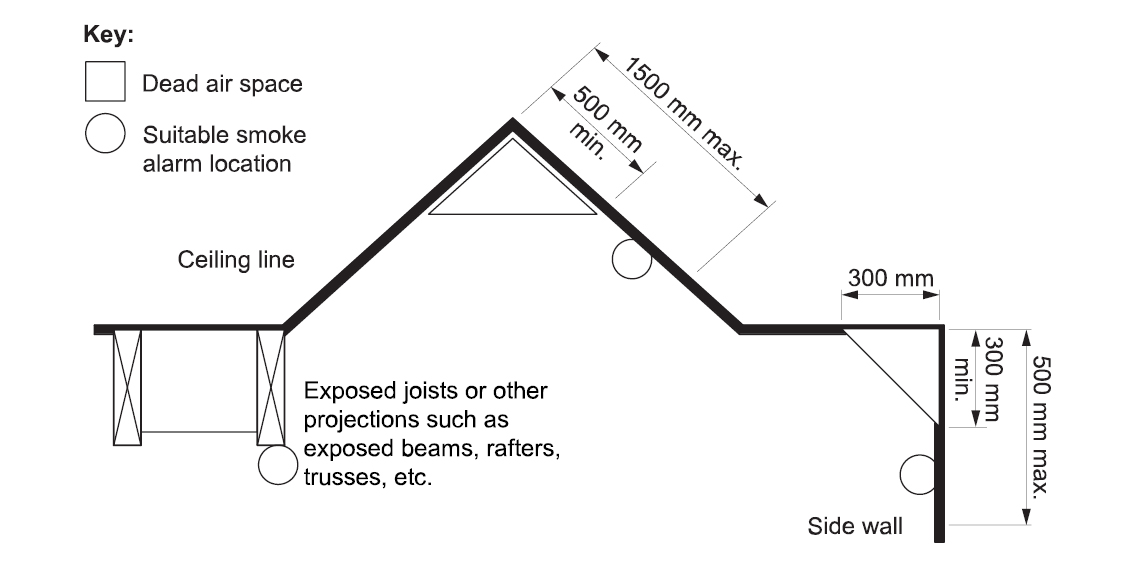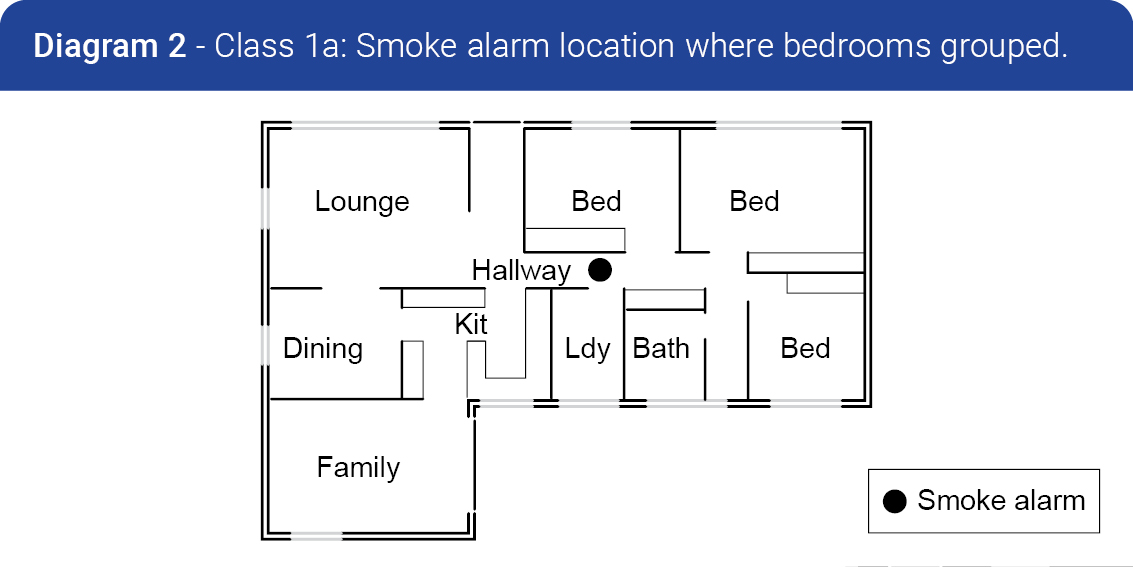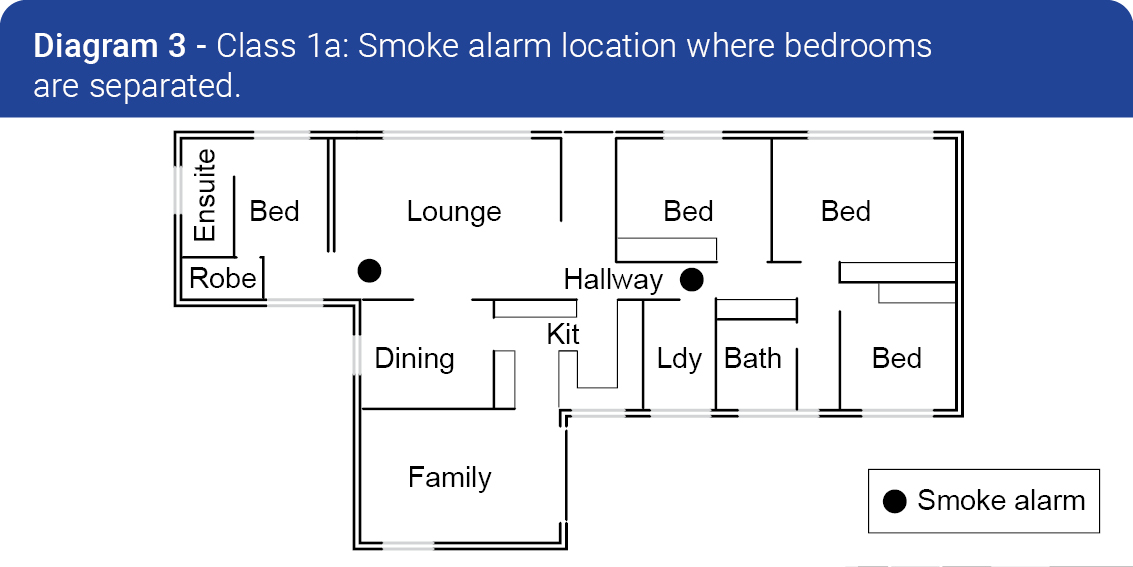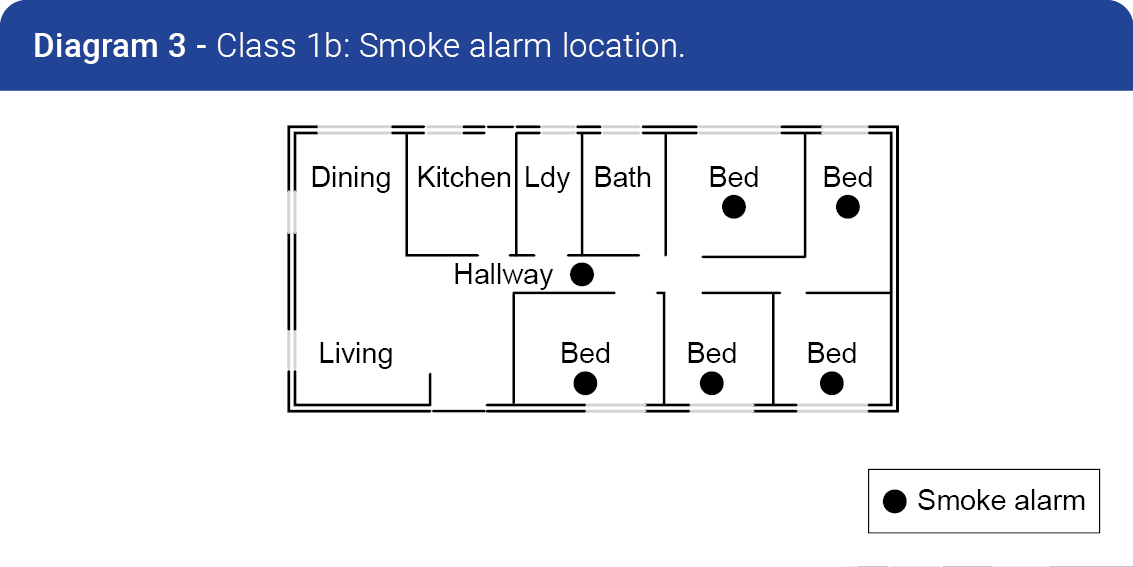Dwellings must have compliant smoke alarms prior to transfer of ownership, rent and hire. The smoke alarms must comply with the edition of the BCA in effect at the time they are installed. They must also be:
- in working order;
- permanently connected to the mains power supply; and
- not more than 10 years old and have not reached their expiry date.
Installing smoke alarms
Care should be taken to avoid dead air spaces which can trap hot air and prevent smoke from reaching the smoke alarm. Such spaces occur at the apex of cathedral ceilings, the corner junction of walls and ceilings and between exposed joists. (See Diagram 1).
Smoke alarms must be installed on or near the ceiling, a minimum of 300mm away from where the ceiling and wall meet. Where it is not possible to install it on the ceiling, it may be installed on the wall, but must be between 300mm and 500mm below where the wall and ceiling meet.
If the room has a sloping ceiling, the smoke alarms must be between 500mm and 1500mm away from the highest part.
Diagram 1 – Installation of smoke alarms to avoid dead air space
Locations
The requirements for the location of smoke alarms depend on the building’s BCA classification.
Class 1a
Description: A single dwelling, such as a detached house, row house, townhouse, terrace house or villa unit.
Requirements: Smoke alarms must be installed in every corridor associated with a bedroom, or if there is no corridor, in an area between the bedrooms and the remainder of the building (see Diagrams 2 and 3).
Smoke alarms are also required on all storeys, without bedrooms, even if those storeys consist only of carparking, bathrooms, laundries and the like.
Class 1b
Description:
- A small boarding house, guest house, hostel or the like, that ordinarily accommodates no more than twelve people.
- Four or more single dwellings located on one allotment and used for short-term holiday accommodation, such as cabins in a caravan park or farm stay.
Requirements: The same location rules apply as for Class 1a described above and also in every bedroom (see Diagram 4).
Class 2
Description: A building that contains two or more sole-occupancy units, such as apartments or units.
Requirements: In general, the location rules are similar to the requirements for a Class 1a building.
Class 4
Description: A single dwelling where it is the only residence in a non-residential building, such as a caretaker’s dwelling which is connected to a shop or warehouse.
Requirements: In general, the location rules are similar to the requirements for a Class 1a building.
Park homes
Park homes or similar dwellings that are subject to transfer of ownership, rent and hire, require compliant smoke alarms.
Who can do the installation?
Only a licensed electrical contractor can connect or disconnect mains-powered smoke alarms.
You can search for a licensed electrical contractor using the Online Licence Search.
Types of smoke alarms
Smoke alarms must comply with Australian Standard ‘AS 3786 – Smoke alarms using scattered light, transmitted light or ionization.’ There should be a marking on the smoke alarm that indicates compliance with AS 3786.
Smoke alarms complying with AS 3786 can be either photoelectric or ionisation type alarms. The two types use different smoke-sensing technology.
The Department of Fire and Emergency Services recommends the use of photoelectric smoke alarms.
Nuisance alarms
Smoke alarms are extremely sensitive and sometimes detect smoke and moisture created by common household activities such as burning toast or hot showers that steam up the bathroom.
To reduce the chance of nuisance alarms, avoid locating them near cooking appliances and bathrooms. If there are no other suitable locations, a different type of alarm may be more suitable in certain locations.
In a private garage associated with a Class 1 dwelling, the BCA allows the use of any other alarm deemed suitable by Australian Standard AS 1670. This is provided smoke alarms elsewhere in the dwelling comply with AS 3786.
Interconnection
Smoke alarms must be interconnected where more than one alarm is installed in the dwelling. This means they can communicate with each other so that if one alarm activates, the other alarms automatically activate.
Interconnection of smoke alarms is not required for a dwelling that was constructed on an application for a building permit made before 1 May 2015.
Battery-powered smoke alarms
A battery-powered smoke alarm is only permitted where there is no hidden space in which to run the necessary electrical wiring for the required mains-powered smoke alarm and there is no appropriate alternative location. Examples may be where the ceiling is concrete, or the home has a flat roof with no ceiling space.
Local government approval for a battery-powered smoke alarm is not required in this circumstance but may be required in other circumstances.
A two-storey home may be allowed a battery-powered smoke alarm for the ground floor where the ceiling is concrete. The owner must not install a battery-powered smoke alarm on the upper floor ceiling if there is sufficient roof space to run the electrical wiring for the mains-powered alarm.
Maintaining smoke alarms
The lessor or owner of a dwelling that is for rent or hire must maintain the smoke alarms so that each alarm is:
- in working order;
- permanently connected to the mains power supply, or where the use of a battery-powered smoke alarm is permitted, the alarm has a 10-year life battery that cannot be removed;
- not more than 10 years old and has not reached its expiry date.
Owners needing information about maintaining their smoke alarms should refer to the manufacturer’s instructions or visit the Department of Fire and Emergency Services.
Smoke alarms in home security systems
By law, smoke alarms must be permanently connected to the mains power supply. Smoke alarms powered through a home security system may not comply because some home security systems can be disconnected at the power point.
Also, a feed from a home security system to a smoke alarm may be 12-volts. This would not comply with the requirement for a smoke alarm to be permanently connected to the 240-volt mains power supply.
Exemption for proposed demolition
You may intend to buy a home and demolish it. If so, and you have given the vendor a declaration of intended demolition (statutory declaration) prior to the transfer of ownership, they are not required to install smoke alarms.
The statutory declaration must state that you (as the new owner) intend to demolish the dwelling within six months from the date of transfer of ownership. If the property is then not demolished within the six months following transfer, you must then install all required smoke alarms.
Penalties for non-compliance
Local governments may take action where compliant smoke alarms are not installed or maintained in accordance with the laws.
Downloads
- Smoke alarms in dwellings for sale, rent or hire fact sheet
- Preventing bed fires video
- Industry Bulletin 86 – Smoke alarms installed in additions or alterations to existing dwellings
- Industry Bulletin 79 – Building Code smoke alarm requirements for residential dwellings (new Australian Standard)
- Industry Bulletin 69 – Use of battery powered smoke alarms in dwellings subject to sale, transfer of ownership, lease or hire
- Industry Bulletin 48 – Smoke alarms as part of a home security system
- Industry Bulletin 41 – No interconnection of smoke alarms required in existing dwellings built before 1 May 2015
- Industry Bulletin 40 – Interconnection of smoke alarms for construction of new dwellings only
Links
- Australian Building Codes Board
Building Code of Australia - Parliamentary Counsel’s Office
Building Act 2011 and Building Regulations 2012 - Standards Australia
Full version of Australian Standards - Reader Room
An initiative by Standards Australia to provide limited, no-fee access to many Australian Standards for non-commercial purposes. - Department of Justice
Statutory Declarations - Department of Fire and Emergency Services
Fire safety around the home and smoke alarm maintenance







